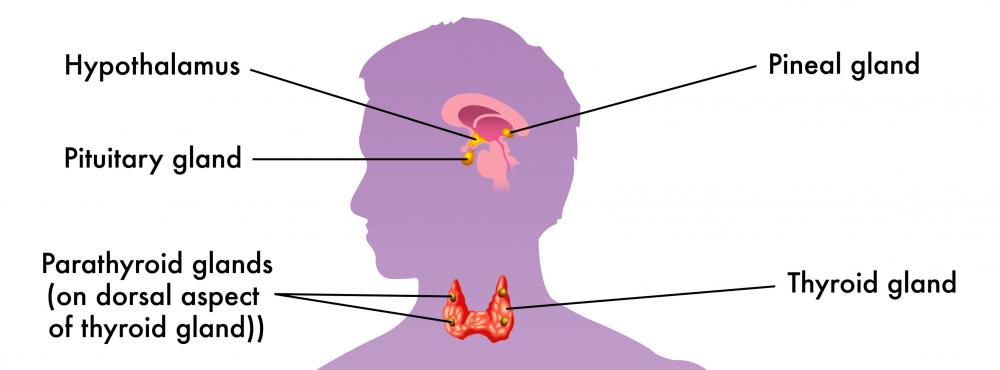At TheHealthBoard, we're committed to delivering accurate, trustworthy information. Our expert-authored content is rigorously fact-checked and sourced from credible authorities. Discover how we uphold the highest standards in providing you with reliable knowledge.
What Is the Connection between the Pituitary Gland and Adrenal Gland?
The pituitary gland and adrenal gland are connected because the pituitary produces chemical messengers, known as hormones, that stimulate the adrenal gland to secrete its own hormones. In this way, the pituitary controls the adrenal glands. It also controls other glands in the body, such as the thyroid, using a similar mechanism. The hormone which is secreted by the pituitary gland in order to regulate the adrenals is called adrenocorticotrophic hormone (ACTH). ACTH stimulates the adrenal glands to produce glucocorticoids, which help the body deal with stress.
In the brain, a structure known as the hypothalamus controls the pituitary gland. The pituitary, or hypophysis, lies below it and the two areas are linked by blood vessels and nerves. Hormones from the hypothalamus travel to the pituitary, causing it to start or stop production of its own hormones. When the hypothalamus secretes a hormone called corticotrophin-releasing hormone (CRH), which it does in response to stress, the pituitary is stimulated to produce ACTH. The connection between the pituitary gland and adrenal gland then comes into play, as the ACTH released from the pituitary travels in the blood stream to the adrenals.

Once ACTH reaches the adrenal endocrine gland it stimulates the outer part of it, known as the cortex, to produce glucocorticoids. Glucocorticoids have effects on the metabolism, the immune system and inflammation. They can help maintain normal blood sugar levels, or increase the amount of sugar in the blood, and cause fat and protein to be released from the body's stores. Glucocorticoids also act to limit the effects of the immune system and inflammation. There are receptors for these hormones on all the cells in the body and they are important in coping with stressful situations, such as illness, starvation and threatening events.

The pituitary gland and adrenal gland, together with the hypothalamus, are involved in a complicated system of feedback mechanisms which turns the production of their hormones on and off. When the amount of glucocorticoids in the circulation rises above a certain level, this has an effect on the hypothalamus, causing it to stop producing corticotrophin-releasing hormone. A lack of CRH means that the pituitary is no longer stimulated to produce ACTH. As ACTH is the messenger between the pituitary gland and adrenal gland, the reduction in its levels means that the adrenal gland stops its secretion of glucocorticoids. Eventually, when the level of glucocorticoids in the blood drops below a specific threshold, this prompts the hypothalamus to secrete CRH again.
AS FEATURED ON:
AS FEATURED ON:



















Discuss this Article
Post your comments